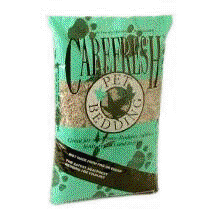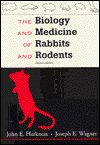

Seems like everybody has allergies these
days. Are more people more allergic to more things, or has the
media simply made us more aware of allergies - and the products
to fight them? For owners who love their pets, being allergic
to one of them can be heartbreaking. An allergy is an inappropriate
response (causing troublesome symptoms) to substances that cause
no response in most people. For pet owners, it's often the skin
(welts, redness, itching) or respiratory system (hay fever or
asthma type symptoms) overreacting to animal dander, particles
of skin and hair or saliva and urine. For cavy owners it can
also be a reaction to dust and pollen in bedding (such as wood
shavings) or hay. If an owner is sensitive, bedding or hay dust
on the cavy may be enough to set off an allergic reaction while
cuddling it.
To weed out the cavy as the culprit and
to hopefully get quick relief from symptoms, an owner might want
to omit hay and bedding from the cage (and the house) for a week.
Cage and accessories should be rinsed well to remove all traces
of dust and debris. Bathing the cavy in a mild cleansing/conditioning
pet shampoo is also important to clear out potentially irritating
leftovers. During this time flat towels or newspaper can be used
on the cage floor. Withholding hay is probably tougher than not
using loose bedding, as most cavies love their hay. If allergy
symptoms lessen or disappear during this week, it's a good indication
the cavy isn't the problem.
Wood shavings can be very irritating to
some people. Cedar is especially bad, and should never be used
as small animal bedding. Cedar contains chemicals that can trigger
allergic responses, and may also cause serious health problems
in animals constantly exposed to it. Pine and even aspen bedding
can trigger allergies as well.
 |
There are quite a few pelleted and/or
recycled bedding products on the market now that claim to be
allergyfree. They are generally more expensive than wood shavings,
but may be worth the price to avoid allergic reactions.
|
If owners don't mind a little extra laundry,
cavies can be kept comfortably on flat towels instead of loose
bedding. Towels need to be changed twice daily. I buy nice thick
towels for cavy cages. Thin ones get urine soaked too fast and
wear out quickly from frequent washings. Wal-Mart often has sales
on nicer towels when the color is discontinued.
|
 |
 |
An alternative is to line the cage pan
with newspaper and use shredded paper as bedding. Personal shredders
are fairly cheap nowadays. Cavies enjoy tunneling under and chewing
up shredded paper. Drawback is paper becomes urine soaked quickly
and needs to be changed every 2 or 3 days.
|
If hay is the allergy instigator, owners
need to experiment to see what (if anything) is tolerable. It
may be as simple as buying a better quality grass hay. Much of
what I see sold at local pet stores is junk - old, brown and
dusty. The dustier hay is, the more irritating it will be to
both owner and cavy. An owner sensitive to hay dust and pollen
may do OK with fresher greener less-dusty grass hay, such as
generally sold by American Pet Diner. The more tightly packed
hay cubes might cause less reaction than loose hay. American
Pet Diner sells a timothy/apple cube called Apple Smacks. Oxbow
Hay Company sells a 70% timothy/30% alfalfa cube called Hay Cakes.
Those a problem, too? Years ago I knew a man who soaked hay cubes
in water, then drained them for his pigs. He claimed the cavies
liked them that way. I was skeptical, but it did keep the dust
to a minimum. Some people are more sensitive to one type of hay
than another. Timothy isn't the only grass hay cavies can have.
Oxbow Hay
Company (800-249-0366) and American Pet Diner (800-656-2691) both sell
orchard grass and wheat grass hay, Oxbow sells brome as well.
Canary and bluegrass are other acceptable grass hays.
If all else fails, Oxbow Hay Company makes
a timothy hay based pellet called Cavy Cuisine. If hay in most
its forms makes life miserable for a cavy owner, the cavy can
make do with Oxbow's timothy pellets added to his diet. It's
a small price to pay for staying in a comfortable home with an
owner who loves him, and will no doubt make up the loss of hay
with plenty of other treats. Perhaps a daily ration of fresh
grass could be fed instead (free of fertilizer and weedkiller
of course). Some pet stores sell small pots of live wheat grass
through the winter months so herbivores needn't go without. Owners
can also grow their own grass and save some money.
Worst case scenario - it is indeed the
cavy causing somebody in the family to have allergic reactions.
Don't pack his bags yet. Routine bathing may help reduce allergens
on the cavy's coat and skin.
 |
A popular veterinary book, The Biology and Medicine of Rabbits and Rodents,
states "Allergies to guinea pig dander and proteins are
common, and commercial shampoo preparations intended to remove
antigens from animal fur may reduce human allergic response."
|
One such product is Allergen Shampoo,
advertised as "non-toxic to cats and all other pets, regardless
of the amount of licking." Another product is DanderSeal
spray, advertised as "Safe, non-toxic and non-irritating
to the eyes and skin of humans and animals." A mild moisturizing
pet shampoo may do just as good a job at eliminating dander,
maybe followed up with a leave-in coat conditioner like Miracle
Coat brand Skin Treatment Spray or Spray-on Shed Reducer. You
can check with local pet stores or veterinary clinics for these
and similar products, or order them from KV Vet Supply mail order
catalog (800-423-8211).
If the owner has become allergic, can
somebody else in the family take over cuddling and routine care
of the cavy? For several years I had cavies as classroom mascots
in a couple 5th grade schoolrooms. Teachers got permission from
all the parents first, and asked specifically about children
with allergies. A couple times we did have kids with allergies
to furry pets in the class. The parents OKed the cavies as long
as their kids didn't have reactions to them. These children were
put on the opposite side of the room from the cavies, didn't
handle them, and did just fine.
Unfortunately, some people are so sensitive
to cavies that just being in the same room with them can trigger
an allergic response. In these extreme cases owners can try keeping
the cavies in a room the allergy sufferer doesn't frequent.
I generally do not like having cavies
shut away from the family, but it may be better for them to be
somewhat isolated if necessary rather than forced to find a new
home. A pair of cavies are likely to do better in this situation
as they have each other for company. If the room is well lit,
with a radio on softly for background noise, and plenty of toys
and chewables to keep busy with - the cavy should do OK.
|
 |
It is important that somebody in the family
can provide the cavies with attention and affection each day.
Give them as much quality time as possible. Cavies can still
be let out for exercise, if kept in an enclosed area with a plastic
tablecloth or small tarp on the floor so all traces of the cavy
can be easily cleaned up once exercise time was over. A plastic
wading pool used as an exercise area is even easier to rinse
out and air dried after use.
 |
All family members should wash their hands
and arms after handling the cavy. Keeping a special shirt handy
to wear while holding the pig, something that can be taken off
afterwards, will help control dander and debris migrating through
the house.
|
As the media constantly reminds us, there
are many medications available to help people cope with allergies.
Chances are, if you're allergic to cavies - you're allergic to
other things as well, so removing the cavy from the home may
not solve all the allergy problems. Like the notorious House
Dust, for instance. How the heck does a person escape that? Sensitivity
tests can better pinpoint exactly what a person is allergic to,
and working with an allergy specialist may be the ticket to making
life much more comfortable for allergy sufferers - and their
beloved pets.
This article and the JPGPR.com
logo are © 1993-2003 Vicki Palmer Nielsen - Jack Pine Guinea
Pig Rescue. No copyright is asserted herein regarding the illustrations
accompanying the article; copyrights, if any, of the illustrations
are retained by the original holders. If you would like to reproduce
anything from the website, please first e-mail Vicki for permission at
:

|









